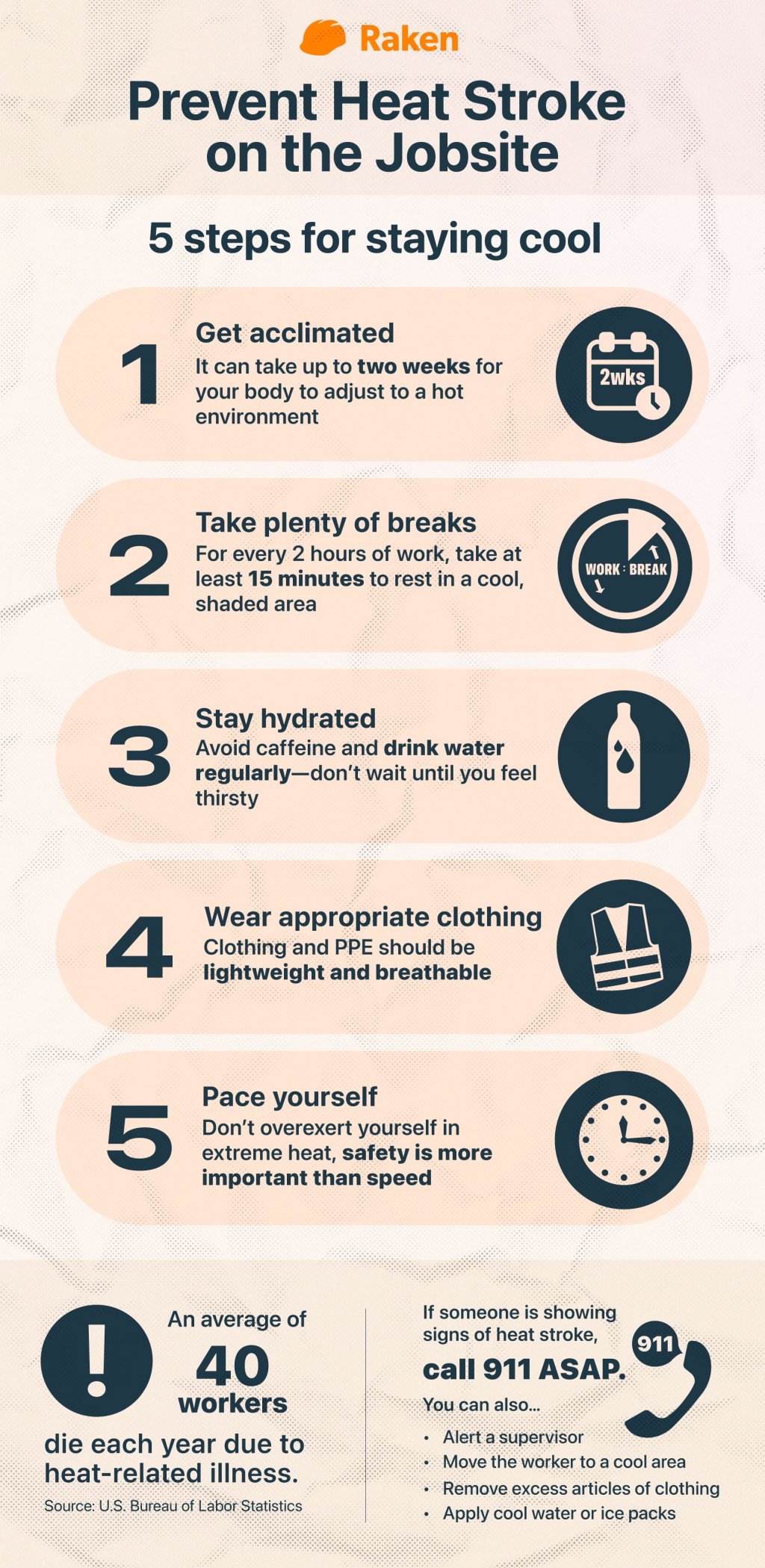Heat Stroke Safety Talk
A hot environment creates hazards in the workplace for employees. Heat stress is something that workers should stay aware of, as hot environments can create indirect safety hazards that employees typically wouldn’t consider. Employees can become fatigued, lose focus on their work, or even lose consciousness from excess heat.
Heat can also cause more direct illnesses such as heat exhaustion, heat stroke, and heat cramps. An average of 658 people die every year due to heat-related illness.
Awareness, prevention, and a quick response can help prevent heat-related deaths. You should always treat heat stroke seriously, because every minute and every symptom matters.
What is heat stroke?
The most serious heat-related illness is heat stroke. Heat stroke is a medical emergency and can be extremely dangerous if left unattended. If you believe that you or someone you know is suffering from heat stroke, call 911 immediately.
You should also get out of the heat as soon as possible. Heat stroke can cause damage to the brain and other internal organs, and can even lead to death. Exposure to prolonged high temperatures (generally in combination with dehydration) results in heat stroke. It leads to failure of the body’s temperature control system.
Prevention of heat illnesses
When working in hot environments, it’s important to be aware of how your body is acclimating. You should immediately make a note of any severe changes — prevention is key when it comes to heat stroke. Here are some things you can do to help reduce your risk of heat stroke:
Allow your body to acclimate to hot environments. It often takes about two weeks for your body to adjust when starting a new job in a hot environment.
Take plenty of breaks in a shaded or cool area. Allow your body to take a rest from the heat.
Stay properly hydrated by drinking plenty of water before you are thirsty. Staying on top of hydration is extremely important, and often when you’re to the point of extreme thirst, you may be bordering on dehydration. Drinking plenty of water and other electrolyte liquids can be a great way to stay on top of preventing heat stroke and other illnesses.
Be aware of your coworkers and monitor each other for signs of heat illness.
Pace yourself and don’t push yourself too hard when your work environment is extremely hot. If exertion makes your heart pound and gasp for air, stop immediately and rest until symptoms resolve.

Signs of heat stroke
Heat stroke is a serious medical condition that occurs when heat exposure exceeds the physiological capacity of the body to cool itself. It results in an increase of the core body temperature and can exhibit a wide range of symptoms. Knowing the signs of heat stroke can help prevent major injury or even death for yourself and your coworkers.
These are some things you may observe or experience with heat stroke:
Fainting can often be the first sign of heat stroke. If someone complains of feeling faint, sit them down in a shaded or cool area, give them cool water to drink, and allow them to catch their breath and relax until they start to feel better.
Dizziness is also a common symptom of heat stroke, and often happens before or after fainting.
Lack of sweating. Your body cools itself off naturally by sweating. When someone doesn’t sweat, they often can start to overheat.
Red, hot, and dry skin can also be a noticeable sign of heat stroke. Keeping an eye on your fellow coworkers can be helpful in preventing heat stroke.
Rapid heartbeat or breathing is often associated with heat stroke.
Heat stroke victims can often exhibit symptoms of confusion and seem disoriented.
Vomiting can occur with heat stroke, and should be followed by liquids to help prevent dehydration.
A body temperature of 104 degrees or higher can be observed in individuals suffering from heat stroke.
Treatment of heat stroke
If you or a coworker are experiencing symptoms of heat stroke, don’t hesitate to seek treatment. The longer you wait, the more detrimental it can be to one’s health. Please follow these steps for someone who appears to be suffering from heat stroke:
Alert a supervisor and call 911 immediately.
Move the worker to a shaded or cooler area if possible.
Remove excess articles of clothing quickly to help bring down the body’s temperature. Too much clothing in hot temperatures hampers the body’s ability to sweat and cool itself down.
Apply cool water to the body or place them in a tub or shower of cool water. Don’t make the water ice cold, as that can cause the body to go into shock. If you’re unable to place them in water, place ice packs in the armpit and groin areas to help lower the body’s core temperature.
Knowing signs of a heat stroke is important
Heat stroke is the most severe form of heat related illness and can be life threatening. Preventing heat related illnesses before they become an issue in the workplace is very important. Knowing the symptoms, signs, and treatment of heat illnesses, especially heat stroke, can be life-saving in some instances.
When in doubt, don’t hesitate to call 911 to get the individual the proper medical treatment that is necessary. You may end up saving your own life, or the life of a coworker, by acting quickly and properly when dealing with heat stroke. Don’t hesitate when dealing with serious medical conditions such as heat-related illnesses.
Find and schedule topics faster
Raken's toolbox talk app makes it easy to choose from a pre-loaded library (or upload your own), then schedule and assign topics for any project. We'd love to show you how in a demo and get you started on a free trial.